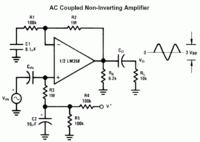ALERTLINKS
Advanced Member level 4

Follow along with the video below to see how to install our site as a web app on your home screen.
Note: This feature may not be available in some browsers.


Both.So same problem. Who do I believe? Multisim or the thousands of example circuits?

Who do I believe? Multisim or the thousands of example circuits?

If move that resistor to the non-inverting input to GND then the positive signal doesn't clip, but that connection is not specified in the datasheet.




That circuit has a 1M resistor from the non-inverting inputs to a voltage generated by the 10k/6.8k divider. That is because it is running from a single supply so to amplify AC signals you need to set your virtual earth point above 0V.
Keith.



I don't particularly like Multisim, but it's primarly a regular SPICE simulator. If it's using manufacturer's SPICE models can be verified, I guess it mostly does. Needless to say that the original LM358 model isn't representing all aspects of the chip's behaviour. It e.g. hides the deadband of the class B output stage and underestimates crossover distortions, as discussed in previous edaboard threads. The problem isn't specific to Multisim, however.I repeat again(my personal opinion) i don't think multisim is a good simulation tool. It is acceptable for ideal OPAMP design but it is not efficiently using the spice model of the components.
Not the latter. The shown output swing is near to real component behaviour. Don't know why you think the output can't reach 0.3V above the negative supply rail? The datasheet tells it can, and I know it does. Although LM358 isn't supporting rail-to-rail, it's fairly suited for single supply operation.we know LM358 is not a to rail output OPAMP. For 12V power supply the output will never reach >11v. But see the attachment[comparator], the output swing to -11.685v which is not possible for LM358...
Anyone accept this?



What are you missing? The problem (missing n.i. input bias) has been clearly stated, but not all contributors did understand it. Business as usual. I don't feel responsible to fight all erroneous believes.what is happening i cant see the updated comments ???





C7 in lower is schematic is decoupling capacitor for lower battery. It is not required in simulation nor its acting similar to C4 in upper schematics.
Voltages add and subtract as in math. When ac is in pos going cycle, it adds to dc level and in negative going cycle it subtracts.
So if dc level is at 10V and 1V ac is coupled, the dc level will vary between 9-11V. Keep in mind different impedances though.
C4 also does have an effect on input impedance in contrast to C7 , but rather ignorable here.
C4 is not required for basic circuit function. It's a filter capacitor that prevents possible AC voltage components superimposed to the supply voltage to enter the signal path.
The RC bias circuit (C2/R1) acts as a high-pass for the signal and a low-pass for the bias voltage. The corner frequency is fc=1/(2*pi*RC) = 0.16 Hz. Frequency components above fc are accepted from the signal input, for lower frequencies and DC, the voltage at the non-inverting input is fed by the bias network.
